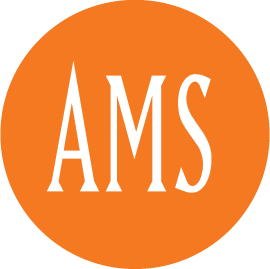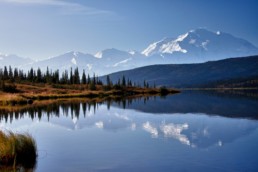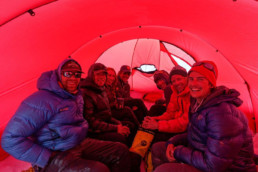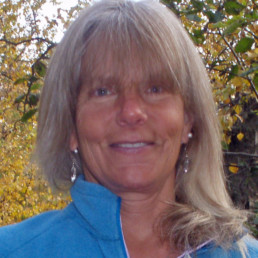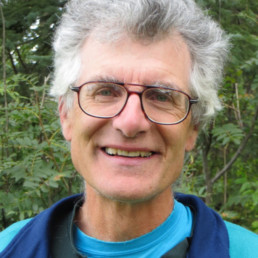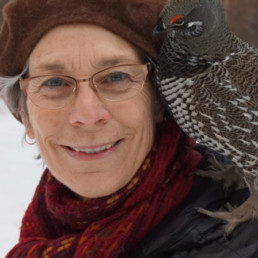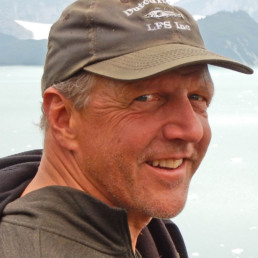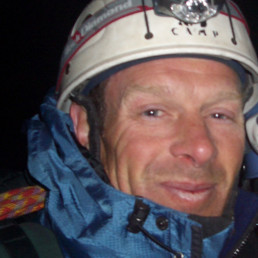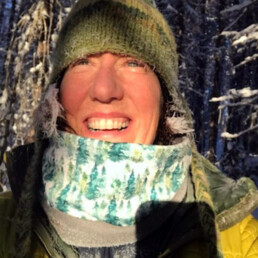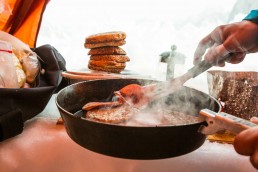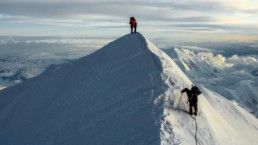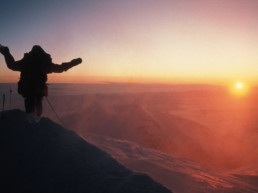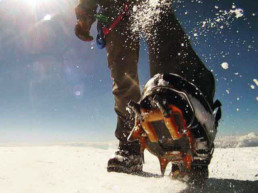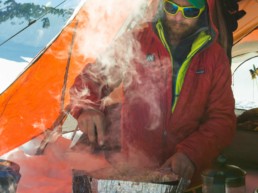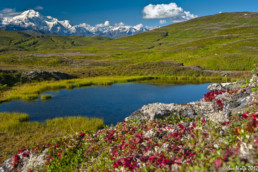Apply for an Alaska Mountaineering School Climbing Expedition or Course
Apply for an AMS Expedition or Course
Download to Fill Out Digitally:
You can view the PDF applications below in your browser, but to fill one out digitally, you’ll need to download and save it to your computer or device.
AMS arranges mountaineering courses and expeditions for climbers from all around the world.
Expeditions:
If you are applying for an AMS Expedition (Denali, Foraker, etc), please download the Expedition Application and save it to your computer or device to fill out digitally.
Courses:
If you are applying for an AMS Course (Mountaineering 6 or 12-day, Glacier Trek, Backpacking, Workshops), please download the Course Application and save it to your computer or device to fill out digitally.
Custom:
If you’re looking for a custom course or expedition, either solo or with a group, we have the logistics, equipment, expertise, and strong guides to make that happen. Tell us your goals, group size, and timeframe, and we’ll provide the guides, climbing routes, and itinerary to make your expedition complete.
Contact us anytime for more information about a Course or Expedition with the Alaska Mountaineering School.
Equipment
Equipment
The leadership and staff at AMS fully comprehend the importance of having the right equipment. Equipment does not have to be fancy, but it is the basis for any successful expedition and has to work. Once the plane flies away and it’s just you and your gear, you might as well forget about the rest of your belongings. In Alaska’s remote wilderness areas, the importance of being self-sufficient is obvious. AMS takes that attitude with its outfitting department. We make sure we have everything we need in Talkeetna to ensure our expeditions go out fully equipped––and that means you have everything you need for any and all circumstances.
Climbers will have unique needs when exploring Alaska’s wilderness, and the evolution of gear has come a long way to manage them. It has been exciting to be part of that process. At AMS, you will see many examples of gear innovations, such as snow saws and sleds, that reflect our constant attempts to perfect how we interact with the environment.
For more information on equipment, please contact AMS.
Safety
Safety & Risk Management
Every AMS program teaches participants to recognize what is dangerous and how to reduce risks to prevent accidents. Because we camp and travel in remote wilderness, which requires self-sufficiency, we are always careful of our actions and understand the possible consequences. That said, we are proud of our excellent safety record, which reflects AMS’s number-one priority: SAFETY.
Most people hear about AMS through word of mouth, usually from program participants. This is not only a great testament to the quality of our programs but also speaks to how we teach our participants to respect and manage potential hazards. This hands-on knowledge is fundamental to the success of every AMS expedition. When each person plays an important role in the safety of the group, we are stronger and more likely to accomplish our objectives. In order to do this, it is absolutely essential that every participant arrives in good physical condition and with a positive mental attitude.
The ultimate responsibility for risk management is in your leaders’ decision-making. AMS instructors and guides are known for their successful leadership experience in managing groups in hazardous terrain. Most guides have a long history working for AMS and are well known by the directors. Every new hire receives background checks as part of the interview process, and is eased into their role in a training position. All AMS staff is required to take an annual crevasse-rescue exam. All staff maintains current Wilderness First Responder medical training, in addition to: certifications in Avalanche Level II, Leave No Trace, and Food Worker Safety. Our extensive evaluation process helps to ensure that we maintain our high-quality staff, as well as superior safety standards throughout all of our programs.
The guides actions and interactions with others consistently demonstrate safety, experience and good judgment. It was a pleasure climbing with AMS and I will definitely return.
—Robert Leidig
AMS’ obsession with safety and careful selection of staff that are experienced, dedicated, passionate, and patient, enables students to learn in a comfortable environment. I achieved more and learned more in 6 days that I thought was possible!
—Lori Blahey
Environment & Community
Environmental & Community Stewardship
All of AMS’s programs are firmly dedicated to environmental stewardship and the ongoing reduction of our impact on our environment. By advancing the sustainability of our day-to-day operations, we continually find ways to conserve and offset. AMS improves its environmental performance through consistent, periodic evaluations, and each year, we make improvements in how energy-smart, water-wise, and climate- and emissions-friendly we are. Through training programs, we ensure that our employees teach and model this mindset, both at our headquarters in Talkeetna, Alaska and in all of our backcountry courses.
EDUCATION
We at AMS deeply value the protection and sustainability of the wild places we visit and make it a priority to help all of our climbers and participants return from the mountains with a better understanding and appreciation of wilderness. AMS designates time on all of our programs to discuss local natural history, resource management, and environmental protection techniques.
RECYCLING
Talkeetna, Alaska is a rural community that prides itself in its proximity to the natural environment. Here, with the Alaska Range and Denali rising over our skyline, minimal-impact living is a priority. AMS helped inaugurate an all-volunteer community recycling program in 2015. We house recycling bins throughout our facility, and built a recycling consolidation site dedicated to cleaning and sorting. AMS harbors a broader ambition than zero landfill: We are aiming for zero waste. We put large, easily identifiable “Zero Landfill Initiative” signs on all our municipal waste containers. We offer one-quart, wide-mouth Nalgene bottles instead of plastic water bottles.
WASTE REDUCTION
Before departing for the backcountry, AMS repackages expedition food to decrease garbage and micro-waste in the mountains. Garbage is separated, compressed in the field, and anything possible is recycled back in Talkeetna. We encourage everyone who uses the backcountry to pick up discarded garbage. The AMS office emphasizes minimal use of paper and printing. By 2020, AMS will view and store 100 percent of client forms in our firewalled database. Thanks for submitting your application materials by email to help us in our efforts!
BULK PACKAGING AND “GREEN” PRODUCTS
AMS purchases field ration food supplies in bulk to reduce packaging. We resupply our own containers for: soap dispensers, hand disinfectant, and household cleaners. We make our own green-friendly cleaners and use washable cleaning rags instead of paper towels. We purchase a pallet of lighter gauge plastic food storage bags instead of Ziplocs to use in the mountains for repackaging food. AMS purchases organic and responsibly sourced foods, paper products, health products, and cleaning supplies. In 2017, we designed and manufactured kitchen snow-collecting bags made of black, non-slip fabric that use solar radiation to melt snow. We estimate that we save a gallon of fuel per expedition.
FOOD AND COMPOST
AMS employees consume vegetables, berries, wild proteins and eggs that we, or local food cooperatives, grow, catch, or harvest. We donate time and labor to our local farms, and work to sustain the farms with volunteer labor. AMS recycles most of its food waste. There are buckets marked for chicken scraps and compost. The chicken coop and compost pile is located at our farm area nearby, which has an electric bear fence. It is essential, however, to keep bears and other wildlife away from human garbage. AMS designated a truck with a bear-proof cap that holds 5 cubic yards of municipal waste, to ensure that bears and other wild animals can’t get into our garbage.
HUMAN WASTE
AMS uses Clean Mountain Cans for our solid human waste during mountaineering programs. This waste is transported to a treatment facility in Anchorage. AMS CEO Colby Coombs is a member of the Talkeetna Water and Sewer advisory board and meets regularly with National Park Service staff and scientists.
COLIFORM TESTING
Preserving our Park resources requires active and informed management based on sound science. Starting in 2018, AMS will provide all trips that travel off-glacier with Coliform bacterial field-testing kits. Coliform is relatively easy and inexpensive to test for. While it is not the most harmful bacteria in human waste, it is an indicator. By mapping the presence of Coliform in the lakes and rivers we visit, AMS will advance the NPS understanding of Coliform present in the ecosystem.
EMISSIONS
In 2017, AMS decreased Type 1 and 2 emissions by replacing all the office windows with high-efficiency triple-panes, all the office lights with LED bulbs, and by doubling the amount of ceiling insulation. Flying into the mountains makes for AMS’s biggest Type 3 emissions. We calculate the amount to be 0.15 metric ton per person to fly into Denali National Park and Preserve. AMS is a contributing member of the Alaska Nature Conservancy, a science-based conservation organization. We purchase 1 metric ton of offsets per expedition via the Nature Conservancy’s offset calculator. AMS also decreases Type 3 emissions by designating a downtown location where staff and clients can walk. We provide financial incentives for our staff to carpool and provide bicycles for staff, including one with a flatbed trailer for picking up bulky items from other locations.
AMS guides constantly maintained an organized camp, trash and human waste were well managed and the group moved safely up the mountain.
—National Park Service 2009
At AMS we believe that contributing to our community adds immeasurably to its strength and health. In a small town, each person can make a big impact. This means not only providing a competitive wage and positive work environment, but also giving our time and energy to our greater community of Talkeetna. As volunteers, AMS’s owners, management team, and guides/instructors contribute to a richer, more positive community in Talkeetna.
Scholarship Program
Our position as a local small business that operates within Denali National Park affords us unique opportunities to further appreciation and stewardship of the Alaska wilderness. We believe that introducing individuals, particularly locals, to conservation is the most powerful way to preserve the wild places we all enjoy. The motivation for good environmental stewardship is most powerful when it comes from a personal appreciation for the places you are protecting. As an educational organization first, even on guided expeditions, AMS tries to instill a core set of values in all of our program participants.
To support access for locals to the mountains and mountaineering skills, AMS offers a scholarship program for local area residents and students, funded by numerous private and internal sources. This type of exposure to the Alaska Range would otherwise be financially impossible for these students. The importance of making the mountains in their backyard more accessible was summed up by one of our most recent scholarship recipients in his application: “How can a child in our area be taunted by this amazing and majestic mountain and never set foot on it or try to climb to its peak?”
Scholarship students write thank-you letters to individual donors and contribute volunteer hours to local nonprofits in exchange for their award. Since 2002, AMS has funded 124 students with $137,082.00 in scholarship funding. AMS scholarship students have taken this opportunity to go far. Some have gone on to college, military service, work as outdoor guides, and world travel.
Internships
AMS offers a competitive and challenging internship program. We have enjoyed watching many first-year interns become all-star mountain guides. Alaska Pacific University, located in Anchorage, features a long-standing Outdoor Studies program that the majority of our interns have been selected from. University of Alaska: Southeast’s outdoor program also provides a solid path to an internship at AMS. If you are interested in an AMS internship, please inquire with your University outdoor program or contact us directly.
Service to Talkeetna
AMS proudly serves our local community. Since its inception in 2002 our scholarship program has supported outreach programs for younger students. Both the Talkeetna and Willow Elementary Schools visit AMS to tour our facility and learn about climbing and the basic concepts of Leave No Trace and caring for natural resources. AMS instructors also visit Talkeetna Elementary School to provide climbing and rope programs to students.
Since 2014, AMS has helped to fund our neighbors, the Northern Susitna Institute Summer Camps, to accommodate an additional group of young students in their environmental education summer camps. AMS hopes all of these students will go on to support stewardship of their local areas and to share these values and love of outdoor recreation with others.
In 2000 AMS brought intensive Wilderness First Responder (WFR) wilderness medicine classes to Talkeetna. For more than 10 years we were the sole sponsors of these programs to educate local wilderness travelers, mountain guides, and remote wilderness travelers. Demand continues to increase, and now multiple WFR classes are held in Talkeetna each spring. At the end of the climbing season, AMS donates extra useable food to the local food bank. AMS employees and their families also contribute useable non-perishable items to school food drives, which benefit local families in need.
AMS managing members and staff are active in the following local organizations: Su Valley High School PTSA, Talkeetna Water and Sewer Board, Talkeetna Skate Park, Northern Susitna Institute’s youth summer camps, Talkeetna Elementary School art programs, Talkeetna Trails Bun to Bun 25K and 5K fun runs, spring roadside cleanup, and the Talkeetna Climbers Memorial. AMS donates funds to the following community enrichment programs and organizations: Talkeetna Historical Society, Denali Arts Council, Wildwood Playground, Talkeetna Public Radio KTNA88.5 FM, Talkeetna Recycling.
While living in Talkeetna all my life I had not experienced the Alaska Range up close. While on the Pika Glacier I learned many new skills and became close friends with everyone on the trip. On day five there was a white out and I got the chance to lead the group while out on a trek with coaching from the guide and now feel more confident in my leadership skills. The whole experience, especially being lowered in a crevasse and ice climbing out, was a trip of a lifetime that I am so grateful to have experienced.
—Luke Graupmann
Our Team
Our Team
All of the exceptional work that Alaska Mountaineering School accomplishes is due to our hardworking and caring instructors, guides, and office staff. Our focus and dedication toward Denali and the surrounding wilderness resonates in everything we do. The success of any expedition into the Alaska Range relies heavily upon attention to detail, and the strength and quality of our team comes from decades of dedication and experience.
“Our guides were clearly among the most respected on the mountain.” —Nicholas Dumesnil
Expert Guides
AMS guides are chosen on the basis of their experience level as climbers and educators. They are true professionals, with extensive training in backcountry emergency medicine, avalanche safety and rescue, and land stewardship. All guides undergo formal training with AMS. Equally important, they understand the leadership and group dynamics, which make expeditions successful, rewarding, and fun. Guides model expert decision-making and judgment calls in order to reach a group and individual’s goals and needs. AMS guides demonstrate superior knowledge and competency in all mountain skill areas, but above all they are amiable, approachable, and understand the importance of effective leadership.
“They’re embarrassingly rich in the one thing that makes a true mountain guide: boots-on-the-ground wilderness experience.” —Anchorage Press, 2015
Emeritus Guides
AMS recognizes the contributions of outstanding guides it has had over the years. While these people are semi-retired from AMS’ Alaska Range programs, they occasionally return to AMS to teach and guide for special occasions. They have been integral to AMS, and our team would not be complete without them.
Support Team
Because you need more than outstanding guides…
Travel & Logistics
Travel & Logistics
Travel to Alaska
Most participants fly into Anchorage International Airport and travel from there to Talkeetna. For information on flights to and within Alaska, contact our local experts:
Talkeetna Travel
907-733-8728
Travel from Anchorage to Talkeetna
Talkeetna is accessible by highway, railroad, or air. Highway travel time is about three hours. Van shuttles offer daily service between Anchorage and Talkeetna during the climbing season. Most shuttles require reservations for service to downtown Talkeetna.
It is essential to make your shuttle or train reservations before booking your flight to Anchorage to ensure that you’ll be able to arrive in Talkeetna on time.
Please contact AMS to request a ride from the train or bus station to your lodging. The summer train station is located ¼ mile from downtown, and the bus drops off 1 mile from downtown Talkeetna.
Talkeetna Taxi
907-355-8294
locally owned, operated, and great customer service
Denali Overland Transportation
907-733-2384
1-800-651-5221
locally owned and operated
Go Purple Shuttle
907-644-8098
popular, reasonable fares, custom times
Alaska Railroad
1-800-544-0552
one northbound train daily to Talkeetna, from mid-May to mid-September
Park Connection Motorcoach
1-800-208-0200
nice motor coaches, stops at Talkeetna Alaskan Lodge from mid-May to mid-September
Nestled against the Chugach Mountains, Anchorage is Alaska’s largest city with a population of just over 260,000 people.
The following accommodations have been recommended by AMS clients and students.
Anchorage Guesthouse
907-276-7226
similar to a hostel and particularly popular choice among climbers and AMS participants, in midtown Anchorage
Executive Suite Hotel
907-243-6366
apartment style suites, near airport
Copper Whale Inn
907-258-7999
downtown Anchorage, next to the waters of Cook Inlet
Hotel Captain Cook
800-843-1950
downtown Anchorage, five star hotel.
Duke’s 8th Ave Hotel
800-478-4837
907-274-6213
Hampton Inn
907-550-7000
You are welcome to stay at the AMS campground before or after your expedition, free of charge. Just bring your own tent and be aware there is no running water. Showers and laundry are available for a small fee at the Roadhouse, which is three blocks away.
Chinook Wind Cabins
800-643-1899
located right next door to AMS
Talkeetna Roadhouse
907-733-1351
10% discount for AMS participants, famous breakfasts & bakery
Talkeetna Hideaway Guesthouse
907-232-7944
Nine furnished guestrooms, free internet, laundry facilities and full kitchen
Talkeetna Alaskan Lodge
877-777-4067
luxury hotel, ¾ mile from downtown & AMS
Talkeetna Cabins
907-733-2227
new efficiency cabins in the heart of downtown
Talkeetna Inn
866-436-5672
on the river, close to AMS and downtown
Swiss Alaska Inn
907-733-2424
family operated, conveniently located, offering a discount to AMS climbers
AMS suggests that you purchase travel insurance immediately after paying your deposit. This insurance may cover costs if you are unable to join your program due to personal emergency, personal or family medical reasons, or if a program is canceled for reasons beyond AMS’ control. It may also cover evacuation and medical expenses in the result of illness or injury.
AMS is not responsible for costs associated with canceled enrollment, programs that cancel for reasons beyond AMS’ control, and evacuations from the mountains. Check with your travel agent for more policies. Many climbers use Travelguard.
Leave No Trace
Leave No Trace
It is an awesome privilege to be able to spend time in wilderness areas so remote and beautifully pristine. We at AMS believe that with this privilege comes the responsibility of preserving this wilderness resource. Our commitment to Leave No Trace is second only to our commitment to safety and that’s one reason we have been awarded a licensed Denali Mountaineering concession since 1983.
All AMS field staff are certified Leave No Trace trainers. They teach the principles of minimum impact camping and traveling skills and model the highest standards at all times, during storms, at the end of the day, and on summit days, whenever and wherever they go.
AMS’ environmental studies curriculum is reviewed yearly and stays current by integrating the latest climate change and sustainability concepts. Staff are regularly briefed by local naturalists and scientists and often work to assist them with data collection.
Safety is our top priority at all times: the safety of our participants, and the safety of the ecosystem.
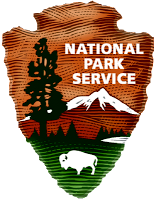
AMS is a licensed concession holder for the US National Park Service (NPS). The NPS concession permitting procedure is a rigorous and competitive process conducted by the NPS and IS Federal Government. AMS meets, and often exceeds, the in-depth safety procedures and guide training requirements that is required of Denali Mountaineering Concessioners. Our guides’ and instructors’ certifications include: Remote Medical Training, Leave No Trace, Avalanche Level II, Rigging for Rescue, AMS Guide Certification, American Mountain Guide Certification.
History
History
The seed that grew into Alaska Mountaineering School (AMS) was planted in 1983 when Brian and Diane Okonek were awarded one of six mountain guide permits for Denali expeditions. The Okoneks, who lived in Talkeetna, were savvy mountain guides with scrupulously high standards. One of Brian’s first students was AMS founder Colby Coombs. During their Denali climb, in which they endured storms and helped in rescues before summiting, a destiny was charted. For ten years, Colby instructed for NOLS, and Caitlin Palmer led university mountaineering programs. Together, they guided Denali expeditions under the Okoneks’ leadership.
AMS embodies the best of the big and the best of the small. AMS’s co-founders understand the importance of combining field standards, professional outfitting facilities, and administrative support. With over thirty years of climbing instruction and guiding on Denali, the AMS founders know that the true strength and value of any mountain guide company is in its guides. All AMS guides, instructors, interns, and owners know each other and eat at the same table. At its very foundation, AMS nurtures a spirit of camaraderie and trust that remains constant.
Brief History Timeline
1983 Diane and Brian Okonek’s Alaska Denali Guiding, Inc. (ADG) awarded Denali National Park Mountaineering Concession.
1996 Colby Coombs and Caitlin Palmer start Alaska Mountaineering School (AMS), from a one-room log cabin.
2001 Colby and Caitlin purchase ADG; AMS and ADG are jointly operated companies.
2003 Alaska Mountaineering School, LLC becomes the sole entity to offer Denali, South American Guiding and Mountaineering Courses.
2005 Denali’s Deadly Ascent, a NOVA episode featuring Colby and Caitlin, airs on public television.
2015 AMS awarded long-term military contract to train Navy SEALs on Denali.
2017 Five AMS Mountain Guides receive the prestigious National Park Service’s Mislow–Swanson Denali Pro Award for exemplary expedition behavior.
Frequently Asked Questions
Frequently Asked Questions
Alaska Mountaineering School is a climber owned and operated guiding company and mountaineering school in Denali National Park. We are the only guide service directly based in Talkeetna, which gives us priceless real-time access to mountain weather and climbing beta on our own backyard, the Alaska Range. Our exceptional Talkeetna facility features an extensive food pantry, expert climbing gym and fully equipped mountain shop. Since our founding in the 1980s, we have guided more than 2,500 Denali and Alaska Range climbers and taught more than 3,500 students. Each season and every climb we fold in what we learn with skills and research to improve and update our mountaineering programs. AMS guides and instructors are the cream of the crop of Alaska Range teaching and guiding community. Year after year we provide you the best courses and expeditions to Denali, Foraker and more.
Wilderness travel in Alaska is serious, and the rewards of the journey are priceless. Safety is our number one priority, and risk management integral to every climb and course. We take your climb to heart, providing a solid foundation of care and expertise to make your experience the safest and best it can be. Although we cannot eliminate the possibility of an accident, AMS goes well beyond the minimum expectation for safety for an organization of its size. Leading our backcountry medicine team is world-renowned high altitude doctor Peter Hackett, full-time life-flight nurse Lance Taysom, and well-known wilderness medicine author Buck Tilton. Each year the team updates medical protocols for new developments in prevention, diagnosis and treatment of wilderness medical emergencies and altitude-related injuries. AMS programs are insured, carry all necessary permits, and leave for the field with medical kits, radios, cell phones, and emergency procedures for all areas of operation. AMS guides and instructors are certified Wilderness First Responders, many are EMT certified, and some are nurses or doctors. All staff are authorized to carry prescription drug kits and perform lifesaving actions in an emergency.
Alaska Mountaineering School is proud of our ability to prepare unparalleled menus. We take notes every year to better our food program, and it shows; our mountain menus have been refined since 1983 for the finest quality, lightweight, tasty food available. Eating good food and enough of it is one of the most important things on a course or expedition. Proper nutrition allows people to better acclimatize and to relax a little bit more without worrying about being hungry. We contract with specialized organic food wholesalers out of Washington who consolidate and ship to Alaska. Alaska Mountaineering School stores course and expedition field rations in giant freezers until departure time. Arriving on the blistering hot glacier with frozen food prolongs freshness and keeps cheese and butter free of mold. Any delay into the mountains is hard on perishables; other operators, with no base in Talkeetna, have no choice but to leave their expedition food in their air service’s hangar.
Alaska Mountaineering School consists mainly of the office and staging area, Mountain Shop, and Yurt, along with the Matt Porter Rock Gym. With its graceful lines, this unique cave-like structure has been featured in a number of climbing magazines. The gym allows AMS guides and participants a place to exercise and hone their climbing techniques and safety systems, as well as practice fixed-line ascension before heading into the mountains. Our facilities are top-notch; we know you will be pleased.
Alongside our five-star courses and guided expeditions, AMS offers custom climbs. We are the best choice for a custom climb anywhere in the Alaska Range given the forty guides who work for us, many of whom are out climbing in between contracts. Whether your goal with us is to take a skills building course, manage a climbing objective like the West Ridge of the Moose’s Tooth, or accomplish a more technical route on the West Face of Mt. Huntington, we are keen about helping fulfill anyone’s dream.
Along with program safety staffing is our top priority, and AMS keeps its staffing manager employed all winter to ensure the job gets done right. Knowledge of the Alaskan mountains and technical prowess are not the only attributes we look for in our guides. Guides are chosen also for their kindness and ability to teach others to become better mountaineers. Like our clients and participants, AMS staff are fully co-ed. Alaska mountaineering as a whole tends to attract more men than women, but having men and women present in most groups makes for a higher quality experience for everyone. Our ratio of female to male participants is 35:65; the ratio for guides and instructors is 40:60. Twenty-five percent of all of our field staff are women. AMS staff are the cream of the crop of Alaska Range teaching and guiding community.
The summit is inherently a main objective of mountaineering, but it is the journey there that truly counts. At Alaska Mountaineering School, our participants feel as though they are a part of the decision-making process. This approach does not slow us down in reaching our goal of the summit but rather makes the entire group that much more equipped to get there.
The average student’s age on our courses is 35 years old; the age range is between 15 and 70. We find that age plays a minor role due to the high pace of instruction and fast learning curve for our programs. The minimum age for students on our courses is 15, and the minimum age for members of our expeditions is 18, with very occasional exceptions made on a case-by-case basis. Our maximum age for regularly scheduled Denali expeditions is 65. However, we can happily accommodate older climbers by arranging a custom program to best suit your needs.
Depending on your previous level of experience and ultimate goals, AMS programs can prepare you for high-altitude wilderness mountaineering. For example, a stark beginner adult who ultimately climbed Denali successfully took these AMS programs spread over four years: Glacier travel and crevasse rescue, 7 day backpacking, 12 day MTC , 12 day MTC with hike out, ice climbing, Denali prep, and finally, Denali West Buttress. To learn more of your options with AMS, see our recommended skills and courses.
We do our utmost to match clients and students with the best guide for their expedition or course. And though we cannot guarantee your pick, you can easily request a particular guide. Assigning guides to expeditions and courses is a dynamic process, and we do our best to let you know as soon as possible who will be leading your expedition or course. Of one thing you can be certain, your AMS guide will be excellent. We make a goal to have a female instructor on every course, especially when there are female participants.
The weather in the Alaska Range, fickle and unpredictable, will dictate our every move, forcing us to be flexible, patient, and sometimes spontaneous. Weather is the one thing we cannot change, only accommodate. Time is best spent being prepared for all types of weather, and you’ll be collecting morning and evening weather observations as part of avalanche hazard forecasting. That said, the saying goes, “If you don’t like the weather, wait five minutes.” Everyone gets accustomed to changing layers frequently, especially high in the mountains. Between April and September, depending on elevation, you can expect temperatures between -30 degrees Fahrenheit to +40 degrees Fahrenheit. The low-lying Talkeetna Mountains or Peters Hills are exceptionally mild compared to the glacier-covered Alaska Range.
Bush planes can fly only when the weather is suitable. Usually weather that prohibits flying persists for only a day or two. If the mountain weather prevents us from flying and courses or expeditions are unable to get to the glacier at the scheduled time, we base out of the Mountain Shop. Clients and students can stay on track with the course curriculum, view slideshows and additional educational media, or practice fixed-line ascension and other climbing techniques in the gym. We have a campground with tents and pads ready for everyone to sleep: you don’t have to spend additional money for accommodations. This allows everyone to stay organized. The moment we get the call from the air taxi, we can mobilize to be there in minutes. Occasionally courses or expeditions can be weathered in the Alaska Range beyond their end date. We will do our best to ensure that your course ends on schedule and most do. Still, we recommend allowing 2-3 days on the return end of your travel plans or purchasing flexible airline tickets in the event that weather inhibits your course from flying off the glacier on time.
AMS operates year round, but winter ascents in the Alaska Range are not everyone’s cup of tea. Courses and expeditions typically run from mid-March to mid-September. That said, global warming has shrunken the spring season and we are launching expeditions earlier each year. The best time should also reflect what works for you. Please see our full schedule to see main programs for the 2017 season.
Expedition timing depends on the mountain and route. Denali and Foraker are thousands of feet higher than any other peak in the range, and starting in April or earlier makes it too cold for most climbers. Some routes, such as Denali’s West Buttress have only one landing option. We schedule our last Denali expedition to return to the landing strip by mid-July over concern that the pilots may tell us we have to walk out. Ice oriented routes like Ham and Eggs on Mount Hunter are best in April; rock oriented routes in Little Switzerland are better in July or August. Plane access dictates when (and where) we go. Courses have many options and can choose locations with higher landing zones with firmer snow conditions.
Brian Okonek who has studied the weather on Denali over the course of 30 years and 30 climbing expeditions explains it like this, “The more I have tried to decipher a pattern with the weather the more I have learned there is no pattern. The same sequence of weather events can lead to vastly different outcomes. The best thing is to be prepared all the time.”
The popular climbing season on Denali begins late April and lasts through most of July, shrinking the acceptable window down to 90 days. All of the launch dates of an AMS expedition have a high chance of success. We make it our goal to get to high camp in as strong a shape as possible, dig in, and wait for a summit day. Ultimately, it is patience and perseverance that will reward you with a view from the top.
Although predicting when storms will roll through the Alaska Range is impossible, April to the middle of May typically provide the best window of time for favorable snow conditions on steeper, lower elevation mountains such as Mt. Hunter. That said, the first ascent of Hunter’s West Ridge was in July so timing is not a hard and fast rule.
There are many locations in Denali National Park and Preserve that were first scouted by AMS. We leave the final selection up to the guides, who take into consideration current snow conditions, temperatures, and students’ strengths. The guides also have to work together with the air taxi service as they decide course location. All courses plan to fly into the Alaska Range glaciers; the Pica, Ruth, and Eldridge glaciers are the most popular for our courses.
Phone reception is available only within line of sight to the Susitna Valley (at a mountain pass, summit, or 14,000′ on Denali). Coverage varies throughout the day. You might be talking and have full bars and the next minute your phone is dead because the satellite went out of range. You can contact AMS for a list of recommended satellite phone rental agencies. AMS team phones are analog with large, reliable batteries. For emergencies and check-ins to the office they are tied to a local provider. Outside of that coverage, we carry a satellite phone.
On our Alaska Range Mountaineering Courses and Expeditions the load is often split between a backpack and a sled. We also double carry to most of our camps to minimize the load and to aid in acclimatization, which allows for lighter packs. On a mountaineering course, under most circumstances, the heaviest a pack weight is around 50 pounds. On a Denali expedition, 60 pounds is a good average except for a couple of days on the upper mountain when pack weights are 75 pounds plus. Because of terrain constraints, as we move higher on Denali, we can put less equipment in our sleds and have to carry more on our backs; pack weights are often 75-pounds plus. That weight goes down as the expedition uses up food and fuel and since soon you’ll be wearing, not carrying, more of your clothes.
Skiing may be a possibility with guide approval and if every individual on a rope team is an excellent skier and. Skiing in climbing boots on glaciers while roped, carrying a backpack, and pulling a sled is challenging even for the most experienced skiers. Unless prior arrangements are made, we use snow shoes to travel to 11,000 feet.
AMS Guides and Instructors are professionals in their field and work hard to ensure your Expedition or Course is safe and successful. They have a real love of what they do. We ask that you observe your guides at their jobs and if you have a positive experience, gratuities are an excellent way to show appreciation. We believe gratuities should be based on the level and quality of your experience and in an amount that meets your budget.
The following information is a general recommendation: Guiding industry standard gratuity is 8-12% of the cost of your program. Typically, this will then be divided equally among the guides/ instructors. Gratuity of any amount can be given directly to the Lead Guide/Instructor or to AMS office staff, and it will be distributed to them. Most Guides greatly appreciate tips, yet tips are not what drives them. Gifts and kind gestures are appreciated but are not required.
You can tip with cash, check, Venmo, or PayPal. We are unable to process gratuities by debit or credit card. ATMs are located a short walk from AMS in downtown Talkeetna. Envelopes are available from our front office. Please contact our office if you have any further questions or to discuss gratuities in more detail.
AMS instructors and guides demonstrate high performance in the field all the time, every trip. Their performance is documented with written evaluations from peers and clients as well as a meeting with the directors before and after every contract. All guides have AMGA or UIAGM mountain guiding certification. First time instructors have successfully completed the AMS Guide’s Course, twelve days of specific teaching techniques and guiding strategies unique to Alaska’s mountains. But most instructors who come to AMS already have an established history of excellence and lead-instructing experience at other well-known outdoor organizations. AMS requires all staff to maintain current Wilderness First Responder certification with biennial re-certification or refresher courses.
In many ways, Alaska demands the most from an instructor because it has the most going on: remote wilderness, extensive glaciation, year round avalanche hazard, extreme winter camping during summer months, mile-wide river crossings, grizzly bears. There are many “certified” guides who do not know how to build an igloo, run a kitchen at 17,000 feet, or teach a class on glaciology. Each of these skill areas requires a thorough knowledge of the discipline in order to effectively lead and teach others. AMS maintains high standards: directors Colby Coombs and Caitlin Palmer know firsthand how all of their guides perform. This knowledge is gained through careful selection and by getting to know the staff personally.
Facilities
Our Unique Facilities
Outfitting an Alaska expedition properly is a mighty task. We built our facilities at Alaska Mountaineering School specifically to do the job right. To support our expeditions and courses, AMS operates from two locations near Talkeetna’s village center.
The overwhelming impression from visitors is, “Wow, I have never seen a place so organized!” AMS’s facilities represent 3 decades of continuous effort. We are strong believers in taking care of the things in our control. This mindset works well in the mountains, too.
HEADQUARTERS: AMS headquarters are centrally located in Talkeetna, at the end of a dead-end road, so we can operate undisturbed. When you arrive you will find our office, food, and gear areas. Our outfitting bays offer plenty of covered space to lay out your equipment for the gear check and rental issue. The AMS food-packing room, where food bins cover the walls around a raised packing table, is legendary. You will get a chance to use it on the first day of your AMS expedition. Our staffing and map room is wallpapered floor-to-ceiling with USGS maps of the Alaska Range. This is where instructors and guides plan routes, are briefed, and are issued radios and satellite phones. Our large heated workshop area is where tents, rental parkas, and sleeping bags are stored and equipment is repaired. One wall holds organizer bins filled with items for our first aid kits; another wall holds items for repair-kit assembly. This property also includes our warehouse, which contains: climbing hardware, ropes, stoves, shovels, plastic double boots, ice axes––everything else you’ll need for our programs and courses. For an expedition to be properly outfitted, you can rely on AMS to have everything on hand. Because we order and prepare everything months and even years in advance, there’s no need for our guides to spend time driving around Anchorage trying to find the right things. Instead, they can focus on your upcoming expedition and get everything done right at our HQ.
AMS’s campus extends across our quiet street, where there is a large yurt for classroom instruction and meetings, instructors’ quarters, and the Matt Porter climbing gym (as featured in Climbing magazine, the Patagonia catalog, and other publications). Tents on covered decks are also available for students, should weather prevent an on-time departure.
I love how convenient the AMS headquarters is in Talkeetna and how thorough the guides and staff are.
—Gina Rzucidlo
With its storied history, highly experienced and qualified guides, and resources in Talkeetna, AMS is “the” guiding service which maximizes one’s potential to summit Denali
—Michael Tiska
AMS as a company and persons are very accommodating, professional and very well-organized. From trip planning to available gear in their shops; they are the best guide company I’ve seen.
—Mark Zorn
It has been a real pleasure climbing on Denali with the excellent logistical support, facilities, and professional guides provided by AMS. From the moment you arrive, and especially on the mountain, you notice how AMS stands apart from its competition. Having been with many mountain guide services in the last 10 years, AMS is by far the best—the guides are friendly, great cooks, and always safe.
—Possum Tomfeld
Why AMS
Why AMS
Mountaineering and wilderness travel in Alaska is serious, and AMS wants your trip to be one of the most rewarding experiences of your life. We take to heart the responsibility of introducing people to climbing, and aim to build a solid foundation from which they can pursue a lifetime of reward in this multi-faceted sport. AMS cares about every individual that enrolls in our programs, and we will work hard to make your experience a great one.
Education is at Our Core: As a guiding company, AMS is a means to summit challenging peaks, but what makes us different is that, at heart, we are a school. We divide our offerings into guided climbs and instructional courses, but whether you’re on an AMS hiking course in the Talkeetnas or a guided Denali expedition, you will gain a greater understanding of every aspect of your trip. We believe that knowledge instills the confidence and foundation for applying skills to any potential climbing situation in the world. With over 35 years of experience teaching and leading more than 3500 clients, we have witnessed the rewards of our dual approach in how our clients develop and achieve and their mountaineering goals.
Safety: Safety is at the heart of everything we practice and preach, and the safety of our teams is our number one priority. Our backcountry medical protocols were developed by our medical director, Dr. Peter Hackett, and medical training supervisor, Lance Taysom, RN, WMT-P. An emergency-room physician, Peter is also a world-renowned researcher on altitude-related illnesses while Lance is the chief Life Flight nurse out of Pocatello, Idaho and often participates on Denali National Park Service ranger patrols. Buck Tilton, author of over 50 books and articles on wilderness medicine, certifies many of our AMS staff. All three help keep AMS up to date on current issues in wilderness medicine. Together we constantly review, update, and monitor all safety and hazard protocols. Our experienced and certified staff has one of the highest student/climber to teacher/guide ratios in the business. AMS programs are insured, carry all necessary permits, and leave for the field with medical kits, radios, cell phones, and emergency procedures for all areas of operation.
Read more about how AMS maintains its record of safety
Proximity to the Mountains: No other Alaska-based guide service enjoys the proximity AMS does. Denali National Park and Preserve is 50 miles north of us. Being based in Talkeetna allows our clients to stay on the premises if the weather becomes unflyable. While other companies will send you back to your hotel to wait for the skies to clear, AMS has a campground set up with tents and pads ready for everyone to sleep. With anchor points on the ceiling and floors, a climbing wall, and a huge field, we are able to use the time to cover a lot of the safety systems we will be using on the mountain. Kicking back in the evenings we can enjoy a big screen theater with a database of a thousand photos. Our base is two blocks from the airport, so the moment we get word, we can mobilize and be there in minutes.
Read more about our facilities
Food: This is not a small thing! The food you eat while you exert yourself at altitude and in harsh weather can mean the difference between having the energy to continue or to put yourself and others in a dangerous situation. We believe that eating enough hearty, nutritious foods is one of the most important components of a successful expedition. Proper nutrition also allows people to better acclimatize and to relax a little bit more without worrying about being hungry. AMS contracts with specialized organic food wholesalers, and our menu boasts the finest quality, lightweight, and tasty foods available. Since 1983, we’ve taken great care to prioritize our food program. According to plenty of satisfied customers, it makes a difference.
Read more about the food at AMS
Talk to Our Alumni
Many of our past students are happy to speak with you about their experience. Ask them about how safe they felt and what to expect.
Please contact us if you would like to connect with someone who has recently been on an AMS course or expedition.
The best part about AMS is that they teach skills and safety awareness and encourage you to practice them. Most guiding companies simply guide and don’t teach.
— Ryan Weber, Denali West Buttress Expedition
AMS is a group of consummate professionals. Their operation is absolutely first class.
— Doug Beall, Denali West Buttress Expedition
Food
Food
AMS is known for providing our participants with delicious food!
Unlike the weather, food is one of the things we can control in the backcountry. At AMS we often joke that “we eat our way up the mountain.” That’s because after the fourth day of a multi-day expedition, anticipating a tasty meal can be a strong motivator to get you to the next camp. We are very aware that freeze-dried meals lose their appeal after a couple days, so we drastically limit our use of them. Instead, AMS opts for providing freshly made pizza, burritos, hash browns with bacon and cheese, Mediterranean pasta, and couscous with olives and sun-dried tomatoes. Our menus reflect years of fine-tuning quantities, ingredients, and seasonings. Our food-packing operation is a sight to behold; guides put meals together and lay them out for accuracy in our large designated space. We schedule regular deliveries to maintain our food supplies, and our wall of commercial refrigeration preserves freshness. These details, and many more, combine to make AMS’s answer to eating right the most comprehensive and successful of any mountain guide company.
At AMS, we believe the best approach to satisfaction is in giving you a choice of what you want to eat. When you contact us with your dietary needs, we accommodate those needs. Your guides pack and freeze all the breakfasts and dinners a couple of days prior to your expedition and include any special requests. (See Note, below) Field rations stay frozen until we are ready to load the plane for the flight to the glacier. In this way, perishables such as cheese and bread stay fresh even if unflyable weather causes delays.
What you eat for lunch is especially important, because feeding your body a steady stream of calories requires that you snack throughout the day. Our solution is in letting you choose what drinks, trail, and lunch foods to pack. After your equipment check, we take you to our food room, where we store over 100 different items to choose from. We calculate how many pounds of lunch foods you will need per day, and you start filling our hanging scales with items you like. If you prefer hot Tang to hot chocolate, you can choose that. If the entire group does not drink hot chocolate, then there won’t be any. This method has proven to be both wildly successful and the best way to insure individual satisfaction. AMS is the only guide company that offers personalized lunches because of our top-notch food room and storage capability.
Note: Please contact AMS if you have any dietary restrictions, peculiarities, or allergies. Our meals can be prepared to easily accommodate anyone with specific dietary needs, but we must be aware of this in advance in order to prepare appropriately.
Food was awesome, awesome, awesome!
—Kotova Olge
The food room is a sight to behold and a great resource for all participants. Well fed climbers are happy climbers…
— Amy Peterson
AMS has very competent guides…we were very organized and the food is equivalent to a 5-star restaurant.
—Naria Musallam
On Denali, Foraker, and other big-mountain expeditions, what we eat on any given day depends on 1) where we are on the mountain, 2) what our climbing strategy is, and 3) how far we are into the expedition. Lower on the mountain, we pull sleds and carry bulkier foods. After the first week, we are careful to pack less perishable foods. Often, people have a decreased appetite at higher elevations, so the food is compact, palatable, and easy to digest. Rations must adjust with the ebb and flow of the expedition, so when we have to get out of camp quickly we have food that is quick to prepare. When we have a rest or storm day, we take the time to prepare more complex meals.
Breakfast
Typical breakfast foods: hash browns with melted cheese and precooked bacon, pancakes and maple syrup, almond granola, and bagels or English muffins with cream cheese and strawberry jam. We usually save the hot porridge meals for summit day.
Dinner
Dinners start with a with hot soup, which aids in hydration and helps everyone acclimate well to higher elevations. Main courses include: rice and bean burritos, chicken and rice, rice noodles with peanut sauce, pasta with red sauce, hamburgers, veggie and chicken stir fry, and yes, even pizza! Vegetarians are easily accommodated. Every other day we include a dessert.
Lunch & Drinks
AMS’s lunch and drink strategy highlights how serious we are about precise rationing. In an effort to bring exact quantities, all expedition members pack their own lunch food, as well as hot and cold drinks for the entire expedition. We utilize an exact packing method and carefully guide you through this process in our food room.
AMS has been packing lunches this way for many years; it’s a strategy that works to reduce waste and ensure your satisfaction.
AMS is an amazing and very well-organized organization. Best thing: they also take care about the diet for the mountains. Would love to have a trip to Denali again next year.
—Saachi Soni
During your AMS course you will learn to cook and prepare all your own meals. AMS provides all of the hearty and nutritious foods for your course. (Don’t be surprised if you don’t lose any weight on the course!) Preparing food and water is a key component to winter camping, and students will learn to make tasty meals. Course rations are packed bulk-style, and each tent group cooks for itself from AMS ration bags issued on the first day on the glacier. Each cook group is supplied with a camp cookbook, and your instructors offer cooking tips. Instructors and students cook several meals together, then student groups prepare meals for themselves.
Proper hydration is encouraged from the time you arrive in Talkeetna until the time you return home. AMS goes by the adage: “hydrate or die.” Mountaineering courses will be on snow for the duration of the course, and all drinking water must be melted from snow. Wilderness courses get water from clear lakes or running streams and treat it with iodine tablets and a filter.
Choosing AMS proved to be the right decision. Guide experience, meal prep, itinerary all contributed to our team’s ability to achieve a summit in a year when most teams did not.
–Brad Skorepa
Home
WHY CHOOSE ALASKA MOUNTAINEERING SCHOOL?
Denali Specialist
Locals know best. AMS is the only Alaska company with 35 years of teaching and guiding on Denali and throughout the Alaska Range.
Safety Record
AMS has a faultless safety record, thanks to impeccably high standards, on-site outfitting facilities, and 24-hour support before, during, and after our expeditions.
Expert Guides
AMS guides are hardworking, fun, and professional. They have earned their reputation by climbing Denali, where nature provides the toughest of training grounds.
34
Years on Denali
480+
Denali Expeditions
3,500+
Mountaineering Students
16,200+
Cheesy Hashbrowns
96,200+
Snow Blocks
8
Dogs
